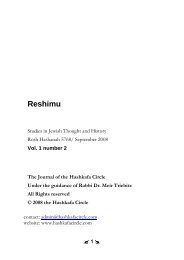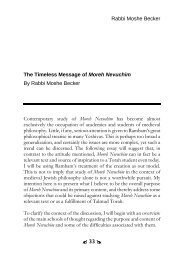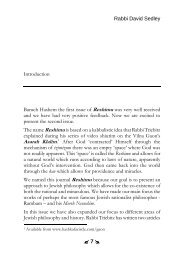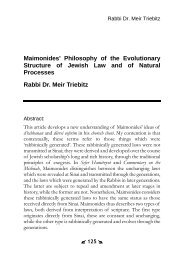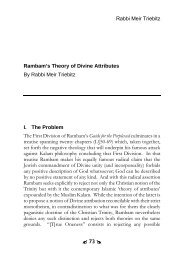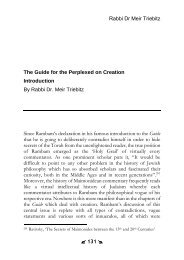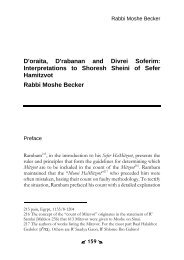Thirteen Midos Shiur 02 Transcription - Hashkafa Circle
Thirteen Midos Shiur 02 Transcription - Hashkafa Circle
Thirteen Midos Shiur 02 Transcription - Hashkafa Circle
Create successful ePaper yourself
Turn your PDF publications into a flip-book with our unique Google optimized e-Paper software.
The <strong>Thirteen</strong> Middos - <strong>Shiur</strong> 2<br />
Rabbi Meir Triebitz<br />
The <strong>Thirteen</strong> Middos - <strong>Shiur</strong> 2<br />
8 Cheshvan (26 October, 2009)<br />
Review<br />
We will begin this shiur, the second in our series on the 13 middos of R’ Yishmael, by reviewing what we<br />
said last week.<br />
We began a discussion on the historical development of the middos. We focused on the famous case in<br />
which Hillel comes in front of B’nei Beseira and answers them regarding the halacha of the Korban<br />
Pesach when Erev Pesach falls on Shabbos. This case is detailed both in the Gemara, the Yerushalmi and<br />
the Bavli and the Tosefta.<br />
The claim of the Meiri is that in fact the halachos were already known but that Hillel presented a new<br />
way of deriving the halacha. And this is in accordance with the way that some of the Rishonim learned<br />
the part of the beraisa of R’ Yishmael that Hillel was doresh seven middos that day in front of B’nei<br />
Beseira.<br />
I would like to elaborate on some of the points that we made last week because I think it is important<br />
that we really understand the text and how what we’re saying fits in with the text of the Gemaras.<br />
Hillel introduced midos, not halachos<br />
Firstly, the contention of the Meiri was that the halacha was already known, and that Hillel only came to<br />
justify the halacha on the basis of the middos. According to the Yerushalmi and Tosefta, first there was a<br />
hekesh, and then (also according to the Bavli) a kal v’chomer and a gzeira shava.<br />
What doses it mean that Hillel came and gave an underlying logical basis, an exegesis of something that<br />
was an existing tradition in Klal Yisrael? Certainly, as the Meiri points out, seven years cannot go by<br />
without Erev Pesach falling on Shabbos. It can’t be that this halacha was a new halacha that was<br />
discovered at this time. The fact is that the Meiri’s contention is very much based in the text too.<br />
They asked two questions of Hillel. The first question that Hillel addressed was can you bring a korban<br />
when Erev Pesach falls on Shabbos?<br />
The second question was how to bring the knife to slaughter the Korban Pesach without transgressing<br />
the prohibition of carrying from a public domain to a private domain on Shabbos.<br />
- 1 -
The <strong>Thirteen</strong> Middos - <strong>Shiur</strong> 2<br />
Rabbi Meir Triebitz<br />
One would think that this discussion was taking place the day before Erev Pesach, planning how to<br />
behave the following day, but we see in the Tosefta in Pesachim, perek 4, halacha 11, “They asked Hillel,<br />
what will be with the nation? They didn’t bring the knife for the korban to the Beis haMikdash.”<br />
They ask using the past tense, “they didn’t bring”, meaning that the act had already taken place. The<br />
discussion actually transpired on Erev Pesach itself. The whole discussion was post factum.<br />
The question was, how did they bring the knives? They looked and they saw that they had stuck the<br />
knives into the wool of the animal.<br />
Hillel then explains the halacha to them as he had learned it from Shmaya and Avtalyon.<br />
This is one proof that the entire discussion was post factum, meaning that Hillel did not come and<br />
decide the halacha at that time, rather it was a fait accompli. It was clear that Pesach took precedence<br />
over Shabbos and it was clear that there must be some way of bringing the knife into the Beis<br />
haMikdash because the act had already taken place.<br />
Derasha based on Hekesh<br />
It is also clear from the Bavli that there are allusions to the fact that the halacha was already known. For<br />
example, the Bavli says they called Hillel and asked him if he knew whether you could slaughter the<br />
Korban Pesach when Erev Pesach falls on Shabbos. He answers that there are 200 Pesachim that take<br />
precedence over the laws of Shabbos. They asked him how he knew.<br />
Rashi explains that every Shabbos you bring four korbanos (and other offerings); four times (more than)<br />
50 (weeks of the year) gives you at least 200.<br />
Hillel is saying that we already have a tradition; we know that Pesach is docheh Shabbos because we<br />
know that every Shabbos we bring korbanos. The question is what is the explanation for this?<br />
Last week we said that what Hillel knew from tradition was the hekesh, the equation. This is a further<br />
proof from the Bavli that the hekesh was not something that came up at that time; the hekesh was a<br />
mesorah they already had. In other words, by saying that there are 200 korbanos that are offered on<br />
Shabbos, it must be that intrinsically he is equating the Korban Pesach with every other korban that is<br />
done on Shabbos.<br />
Shimush Talmidei Chachamim<br />
The second proof that in fact the hekesh was already known is that it says that Hillel was meshamesh<br />
two Gadolei haDor. He was involved in exegesis the entire day. He started giving them mussar saying<br />
why should I become your leader? You are lazy because you were not meshamesh the two Gadolei<br />
haDor.<br />
- 2 -
The <strong>Thirteen</strong> Middos - <strong>Shiur</strong> 2<br />
Rabbi Meir Triebitz<br />
What does meshamesh mean? Later on when the issue arises of how to bring the knife for the korban<br />
on Shabbos, Hillel says “kach mekublani mi-Shmaya ve-Avtalyon”. We see that the Gemara uses two<br />
different terms: meshamesh and mekublani.<br />
What do these terms mean?<br />
There is a gemara in Brachos 47b in the name of Acheirim which says “even someone who has learned<br />
scripture (koreh) and mishna (shanah) but has not been meshamesh a talmid chacham is an am<br />
ha’aretz.” Rashi here explains that meshamesh means sevora, logical reasoning. We have koreh (Torah<br />
she b’chtav), shanah, (Torah she b’al peh) and shimush (logic).<br />
When speaking about the halachos that involve the gzeira shava, Hillel says that he was meshamesh<br />
Shmaya and Avtalyon. What is shimush? A hekesh is sevora.<br />
In being meshamesh Shmaya and Avtalyon he produced a gzeira shava which we learn is really based<br />
upon a hekesh. He also produces a kal v’chomer which is also sevora.<br />
Tradition is not based on Sevora<br />
However, when they bring the knives in there is no sevora. Therefore he says “Kach mekublani”. What<br />
tradition did he have?<br />
It says he saw the act and remembered the halacha. The use of the word halacha is interesting. Halacha<br />
usually means a didactic, not logical reasoning. So what does Hillel mean when he says he has a tradition<br />
from Shmaya and Avtalyon? Later on, the Gemara goes on in detail on this topic and says “This halacha I<br />
heard and then forgot.” How or why does he forget the halacha and then remember it?<br />
The Gemara continues and explains in Pesachim 66b “Let the Jewish people do what they do – if they<br />
are not prophets, they are the descendants of prophets.”<br />
The same language appears in the Tosefta 4:11 where Hillel answers regarding how to bring the knives.<br />
He says the people have ruach hakodesh and if they are not prophets, they are the descendants of<br />
prophets.<br />
Why does the Gemara say that Hillel heard the halacha and then forgot it? Then he remembered the<br />
halacha and said this is the tradition I received (kach mekublani) from Shmaya and Avtalyon.<br />
On amud beis the Gemara does not mention that Hillel remembered and received the tradition from<br />
Shmaya and Avtalyon.<br />
It could be that the halacha Hillel is speaking of is the minhag; what the Jewish people do. Let them work<br />
it out - if they are not prophets, they are descendents of prophets.<br />
- 3 -
The <strong>Thirteen</strong> Middos - <strong>Shiur</strong> 2<br />
Rabbi Meir Triebitz<br />
We see something interesting here. Hillel had two mesorahs from Shmaya and Avtalyon. One tradition<br />
he had was sevora - hekesh. That is shimush.<br />
Another tradition is that he knew certain things from Shmaya and Avtalyon. Not to tell the people what<br />
to do but rather to let the people navigate because they have prophecy. We see an example in the<br />
Gemara in Sukkah. The Gemara talks about Hoshana Raba and the Gemara says “minhag neviim hu”.<br />
The people’s behavior establishes the way things should be done.<br />
What do we see from these two things? We see that the Gemara is indicating that Hillel was not coming<br />
to tell B’nei Beseira any type of new halacha. Clearly, they were well aware of the halacha from the<br />
tradition of Klal Yisrael. Rather than inaugurating a new halacha, Hillel was doresh the kal v’chomer and<br />
gzeira shava which provided an exegetical basis for that which was already known.<br />
Gzeira Shava moves beyond Hekesh<br />
I would now like to move on to the second point we discussed in the last shiur.<br />
It is clear that Shamaya and Avtalyon taught Hillel the concept of hekesh. The B’nei Beseira already knew<br />
the hekesh. The novel idea that Hillel taught them was the gzeira shava and the kal v’chomer.<br />
The gzeira shava represents a step beyond the hekesh.<br />
The Gemara Rosh Hashana 33b-34a gives us more insight into the relationship between hekesh and<br />
gzeira shava and how the hekesh is the basis for the gzeira shava and how the gzeira shava goes beyond<br />
the hekesh and becomes, in a sense, more powerful than the hekesh.<br />
The Gemara discusses how many shofar blasts are blown on Rosh Hashana.<br />
There are two types of blasts. There is a straight blast – a pshuta, and a broken blast which is called a<br />
teruah (this includes what we call both shevarim and teruah). One set is called a tekia teruah tekia. The<br />
Gemara is trying to derive how we know that on Rosh Hashana we make three sets of three blasts.<br />
The Gemara brings a beraisa because of the hekesh. The word teruah does not appear three times in<br />
the whole of Rosh Hashana. It appears twice in Rosh Hashana and once in Yovel regarding Yom Kippur.<br />
The Gemara says how do we know that teruah means shofar blast? The Gemara quotes the verse in<br />
Vayikra which talks about the shofar being blown on Yom Kippur. There it says the teruah is blown with<br />
a shofar, so even though in Yovel it specifies “bachodesh hashvi’i” it must be possible to equate this with<br />
the verse in Rosh Hashana and say that when it says teruah for Rosh Hashana it must also mean shofar<br />
blast, because how else can you call this a hekesh?<br />
The Gemara asks how do we know to blow a pshuta, a single blast, before a teruah? We learn this by<br />
equating Yovel with Rosh Hashana. On Yom Kippur we blow a tekia then a teruah then a tekia, so<br />
therefore we learn that we do the same thing on Rosh Hashana.<br />
- 4 -
The <strong>Thirteen</strong> Middos - <strong>Shiur</strong> 2<br />
Rabbi Meir Triebitz<br />
The Gemara asks, but how do we know that on Rosh Hashana we blow three sets of three blasts? It only<br />
says teruah twice in Rosh Hashana, and once in Yovel. How do we know that what is written in one place<br />
also holds true in another context? We see that the word shvi’i appears in both places so we can learn<br />
with a gzeira shava. We mix it up as if it is all one text. First the Gemara brings a hekesh and then a<br />
gzeira shava.<br />
If you have the gzeira shava, why do you need the hekesh? The Ritva learns that the hekesh only tells<br />
me that both are with a shofar and both have a single blast preceding and following the broken blast.<br />
The hekesh equates the two verses. But how do we know to take the verse in Yovel and the verse in<br />
Rosh Hashana and learn them as if they are one verse? This is what the gzeira shava tells us.<br />
The Ritva says the gzeira shava tells me that on Rosh Hashana we blow three sets of three blasts. So the<br />
Ritva asks, why can’t we learn this with a hekesh, with logic? It’s based on a gzeira shava for which the<br />
Ritva tells us we need a mesorah, a tradition. We don’t need a tradition for a hekesh. The Ritva says you<br />
can’t learn a gzeira shava from a hekesh. A hekesh can only equate things, but it can’t tell me to take the<br />
pasuk in Yovel and put it into Rosh Hashana. A hekesh is only a logical equation. The gzeira shava is more<br />
powerful because once I have the equation, the gzeira shava picks out two words which are the same<br />
and says now everything becomes interchangeable. The gzeira shava tells me how to apply the halachos<br />
of one verse to another.<br />
We can’t possibly determine that on Rosh Hashana we blow three sets of three blasts by using only a<br />
hekesh.<br />
Rashi learns that the hekesh is telling me the same thing as the gzeira shava. Rashi says that if we don’t<br />
have it as a tradition from Sinai, then we bring a hekesh b’atzmo.<br />
R’ Akiva Eiger in Gilyon haShas points out that in Sukkah 31a where the Gemara asks how we know that<br />
if an Esrog must be “pri eitz hadar” that the other minim must also be hadar, the Gemara learns a<br />
hekesh. Here Rashi learns explicitly that hekesh is halacha le Moshe miSinai, which contradicts what<br />
Rashi learns regarding hekesh in Rosh Hashana. R’ Akiva Eiger leaves the question unresolved (tzarich<br />
iyun).<br />
I want to claim that Rashi does not contradict himself. Rashi learns that there are two types of hekesh.<br />
Rashi learns that in Rosh Hashana the Gemara is speaking about one type of hekesh; the hekesh which is<br />
the basis of a gzeira shava. Every gzeira shava is preceded by a hekesh; every equation of two words<br />
begins with logical reasoning. Rashi learns that before I had the terminology to equate two words with a<br />
gzeira shava, I had the hekesh; the logic.<br />
The fact is that sometimes in Chazal we see a hekesh. We did not eliminate the hekesh. The hekesh can<br />
exist as a middah in and of itself rather than as a basis for a gzeira shava. This is the second type of<br />
hekesh. That is what we see from Rashi in Sukkah 31a. There is a hekesh that serves as a precedent to a<br />
- 5 -
The <strong>Thirteen</strong> Middos - <strong>Shiur</strong> 2<br />
Rabbi Meir Triebitz<br />
gzeira shava and a hekesh that stands independently. We learn the hekesh, which is logical reasoning,<br />
from our Rebbe, and from this stems the gzeira shava.<br />
The Ritva asks why would we need gzeira shava? The answer is because a gzeira shava is a more<br />
powerful technique than a hekesh. A hekesh is only a logical equation; a gzeira shava which is based<br />
upon the logical equation established by my Rebbe is the formalization of that sevora and can be used<br />
to do more.<br />
We see this clearly in the Gemara in Rosh Hashana.<br />
Why is the hekesh the basis for the gzeira shava? The Yerushalmi states very clearly that if we were to<br />
equate any two words we can end up with a major misunderstanding, as in the translations for Ptolemy<br />
which understood the first verse of the Torah to mean that an entity named Bereishis created Elokim.<br />
We need the tradition, the hekesh, to give us the correct understanding.<br />
Why does the gzeira shava need to come from a hekesh? The hekesh is logical; everything needs to be<br />
logical in order to have control. According to the Ritva, once I have the logical equation between two<br />
things, then I can invoke the model of the gzeira shava and use the powerful tool of making them<br />
identical. That is how to derive the halacha.<br />
It is interesting that there is a dispute between Rashi and the Ritva on how to read the Gemara in Rosh<br />
Hashana. According to the Ritva, the hekesh doesn’t give me the three sets of three shofar blasts on<br />
Rosh Hashana because a hekesh only equates things; it doesn’t make things identical. A hekesh means x<br />
equals y. A gzeira shava means x equals x.<br />
However, Rashi learns it differently. Rashi learns that the hekesh actually means x equals x.<br />
I would like to claim that you get two principles from the two Rishonim which are true.<br />
By the way, Rashi is makeish b’atzmo, in other words, saying that in Rosh Hashana you have three is not<br />
a logical equation. Why would a person learn that as a logical thing? That’s what Rashi learns in the<br />
Gemara.<br />
According to the Ritva, the gzeira shava produces chidushei halachos.<br />
Of course, Rashi agrees with the Ritva; every gzeira shava is preceded by a hekesh.<br />
There are two ways to answer this. One answer is that a hekesh equates two things, or two pesukim. For<br />
example, in Rosh Hashana it says teruah twice; each time it says teruah I’m making a logical hekesh with<br />
the teruah in Yom Kippur. In each pasuk I’m making a hekesh. I make a hekesh between one teruah in<br />
Rosh Hashana with one teruah in Yom Kippur. I make a hekesh between the other teruah in Rosh<br />
Hashana with the teruah in Yom Kippur, so you get two sets in Rosh Hashana and you get one set in Yom<br />
Kippur. That’s not good; they are not equal, they need to be equal.<br />
- 6 -
The <strong>Thirteen</strong> Middos - <strong>Shiur</strong> 2<br />
Rabbi Meir Triebitz<br />
How can we solve this? We can’t break one of the sets in Rosh Hashana so I make three in each one.<br />
One could say that Rashi is making a textual hekesh and the Ritva is making a conceptual hekesh.<br />
Gzeira Shava is Halacha le-Moshe mi-Sinai<br />
We have already clearly established that a gzeira shava is preceded by a hekesh. I don’t make up two<br />
words in each one and equate them, rather, my equation is based upon logic learned from the previous<br />
generation. An equation that comes from the previous paradigm is called halacha le-Moshe mi-Sinai. On<br />
the basis of this equation, I create a formalization, which is the gzeira shava.<br />
Incidentally, the concept of halacha le-Moshe mi-Sinai doesn’t appear in the Talmud with respect to the<br />
gzeira shava – rather the Talmud uses phrases such as “a person may not make a gzeira shava by<br />
himself” or “received from his teacher”. It doesn’t say this is halacha le-Moshe mi-Sinai; it says “learned<br />
from my rebbe” which means each generation learned from the previous generation taking us all the<br />
way back to Sinai.<br />
Paradigm shift from logic to formal model<br />
Besides the more powerful formalism that we have here, Hillel introduced something very interesting. A<br />
hekesh is intuitive; it is logical. A gzeira shava is a formal model. Once we have a formal model, we have<br />
a common language with which to discuss. You can’t argue with logic.<br />
This is what we see in Pesachim; once Hillel sets forth the middos, B’nei Beseira have something they<br />
can discuss. This is similar to the Gemara in Brachos 28a where we see that once they opened up the<br />
Beis Midrash they were able to engage in halachic discussion.<br />
The yesod of Hillel is that we have a more powerful technique and we have a basis for discussion; a<br />
dialectic in the halacha.<br />
We can see a possible allusion to Hillel’s approach of introducing commensurable debate in halacha in<br />
the famous Gemara in Shabbos 31a.<br />
A man came to Shamai and asked, “How many Torahs do you have?”<br />
“We have two: a Written Law and an Oral Law.”<br />
“I believe in the Written Law, but I don’t believe in the Oral Law. Convert me on the condition<br />
that you teach me only the Written Law.”<br />
Shamai sends the man away.<br />
The man went to Hillel, and Hillel converted him. Then he began teaching him the letters of the<br />
aleph-bet (Written Law) and demonstrated using rational argument that it is impossible to have<br />
a Written Torah without an Oral Law explaining it.<br />
- 7 -
The <strong>Thirteen</strong> Middos - <strong>Shiur</strong> 2<br />
Rabbi Meir Triebitz<br />
Hillel felt you could reach people through reason. He believed in the power of persuasion. The middos<br />
created by Hillel are the models of commensurability which allow scholarly exchange between talmidei<br />
chachamim.<br />
Another example in Shabbos 31a is the convert who came to Shamai and asked to be taught the Torah<br />
“while standing on one foot”. Shamai sent him away. Hillel said “I’ll give you a klal; the rest you can<br />
learn.” Hillel was confident of the fact that the Torah can be learned.<br />
We can also see this concept in the final story there, when someone wanted to convert on the condition<br />
that he become the Kohen Gadol. Though Shamai sent him away, Hillel first converted him, then<br />
persuaded him through rational argument to give up his condition of being the Kohen Gadol.<br />
What do we learn from these three stories? Hillel created middos so that the Torah could be debated<br />
rationally. Hillel created formal logical steps - there is a model, there is an equation, there is a rule that<br />
we all agree on, that we know how to use. This allows technique in generating halachos and enables<br />
commensurable scholarly exchange.<br />
These three stories from the Gemara in Shabbos are reflections of Hillel’s approach that there is no<br />
impediment to teaching a person Torah. Hillel believed in the power of persuasion. Shamai held that you<br />
learn something because it is tradition, there is an authority and there is no room for debate. B’nei<br />
Beseira were students of Shamai.<br />
Transformation from tradition to rational debate<br />
The middos introduced by Hillel allow us to rationally persuade a person.<br />
Each story in Shabbos brings a different aspect of logical persuasion.<br />
The Talmud in Eruvin says that the halacha is according to Beis Hillel because they taught the opinion of<br />
Beis Shamai first. They were able to do this because they were confident in their ability to debate, and<br />
that through conversation could reach a common conclusion that everyone agrees to. Hillel’s stance is<br />
that logic can bring us to a commonality of position.<br />
The personality of Hillel (about which there is much written in the agadata) is a function of the fact that<br />
Hillel introduces the seven middos. The seven middos are objective models on the basis of which people<br />
can continue a logical dialogue.<br />
The new paradigm is built upon the previous paradigm – halacha le-Moshe mi-Sinai<br />
We understand the concept of mesorah to mean that the previous generation established a logical basis<br />
upon which I can construct this model; this middah. Even where there is a change of paradigm, the new<br />
paradigm rests upon the old paradigm.<br />
- 8 -
The <strong>Thirteen</strong> Middos - <strong>Shiur</strong> 2<br />
Rabbi Meir Triebitz<br />
There are no arguments in the Talmud about the concept of the existence of the middos. The details of<br />
how to apply the middos are debated, but their existence is not. The fact that everybody accepts the<br />
middos means that they are tradition.<br />
Hillel constructed a formal model based upon a hekesh. Everyone agrees with this model; everyone<br />
accepts that the formalization of the gzeira shava is the logical continuity of a hekesh. That is the<br />
element of halacha le-Moshe mi-Sinai.<br />
- 9 -



